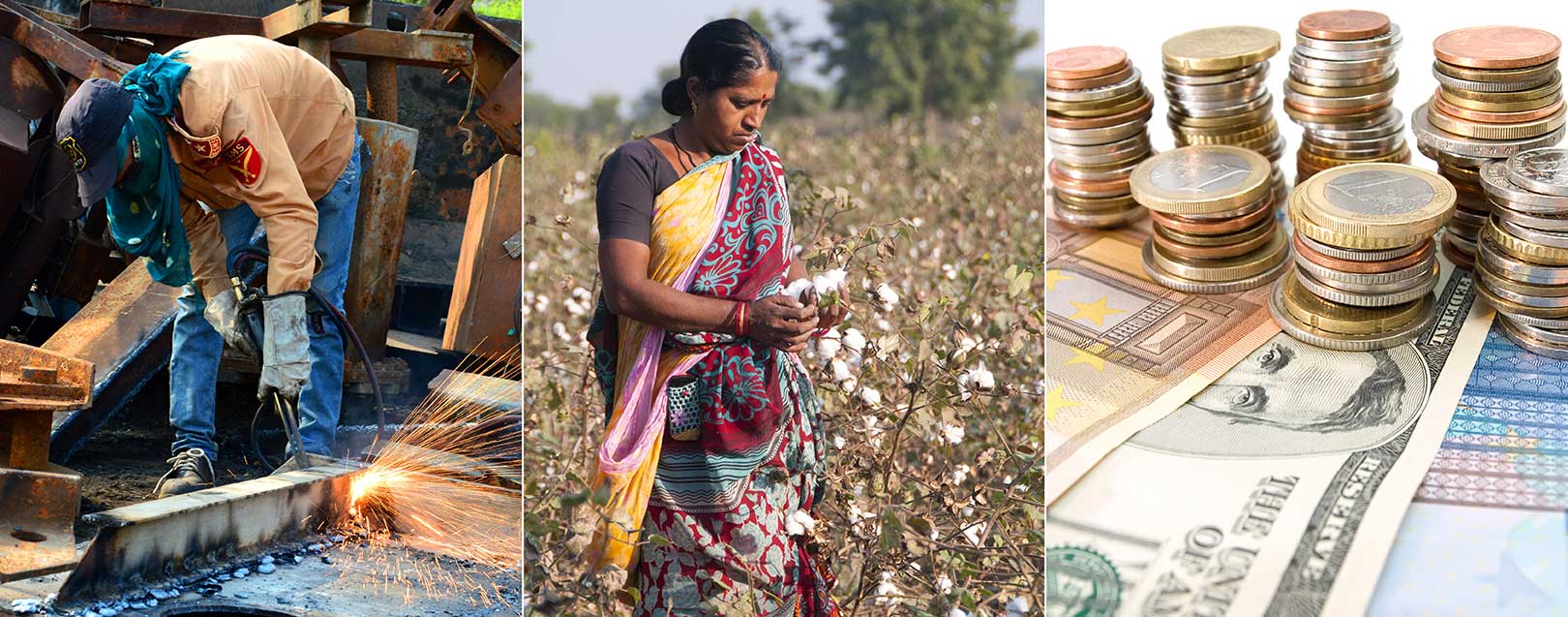
Marginal growth in core sector industries; Cotton sowing pushes up Kharif sowing acreage; Forex reserves hit life-time highs
By Abin Daya
Change is an unavoidable part of life - and of doing business. One of the biggest changes to the way we do business happened last Friday, with the rolling out of the GST. Yes, there will be disruptions in the short term and the cost of compliance will go up. Also, many small businesses will lose the tax arbitrage that enabled them to price below that of the larger companies. It will also increase the financing cost of business, particularly for those engaged in foreign trade.
Speaking of financing, even that is not going to be easy. While credit growth is down because of low credit demand driven by the leveraged position of corporates combined with muted demand, even where businesses wish to borrow, the ability of banks to lend is affected due to the impairments in the existing portfolio. Added to this is RBI’s own assessment that asset quality might go down even further, thus resulting in lenders becoming more risk averse.
We start this week’s update with the performance of the core sector, which is indicative of the overall industrial performance in the country. Coming on the back of a lacklustre 2.8% growth in April, the current number of 3.6% might seem to be an improvement, but compared to what it was during the same period last year, it is a disappointment.
What is encouraging is the increased agricultural activity due to the excellent rains. Overall acreage has gone up by 20% and even pulses sowing, which had started off on a slow note, has picked up significantly, laying to rest the fears that growers might have moved away from the crop.
Post implementation of GST, there still needs to be clarity on a number of issues, export benefits being one of them. While the mid-term review of the Foreign Trade policy was supposed to throw some light on a few of these, the same has been delayed till Sep 2017, forcing us to wait for some more time. We have been getting queries from customers on the impact of GST on their business, and have been trying to answer them as best as we can. The learning curve is going to be steep for all of us, at least for the next 3-4 months. Bear with us, while we too, go to school for the time being!
Core sector industries grow at 3.6% in May
- The eight core sector industries grew by 3.6% in the month of May 2017, as against 5.2% during the same month last year

- While growth improved from 2.8% of Apr 2017, Y-O-Y growth seems to have hit a speed bump
- Output declined in coal (-3.3%) and fertilisers (-6.5%), while a high base made growth problematic for Steel

- Growth in steel sector, which has been performing impressively in the recent past, declined to 3.7% during the month from 13.4% a year back, and 9.3% in April
- It might be recalled that the steel sector had gone through a longish period of negative growth, before recovering in Q4 of FY16, supported by import restrictions imposed on Chinese imports

- As a result, the industry is now moving to a period of high base, particularly in Q2 of the FY, which could impact growth figures going forward
- The Fertiliser industry has been going through a period of downturn since demonetisation, and has had just one month of positive growth, since Dec 2016
- While Natural Gas, Refinery Production and Electricity Production have helped pull up the performance from last month’s level of 2.8% growth, the sector will have to contend with a high base in the month of June
RBI releases Financial Stability Report for June 2017
- The Reserve Bank of India has released the Financial Stability Report, a biannual publication released every June and December
- The report reflects the overall assessment on the stability of the Indian financial system, and its ability to recover from systemic risks
- The report acknowledges that while India’s financial system remains stable, the banking sector continues to face challenges
- It also identifies the twin challenges of a highly leveraged corporate sector, and a stressed banking sector as roadblocks to credit growth
- Domestic macro-economic conditions are stable at the moment, with political stability and low current account deficit being major positives
- Despite these and the easy liquidity conditions prevailing post demonetisation, weak investment demand, which is an outcome of the twin challenges mentioned above, has led to low credit demand
- Added to this are the deteriorating asset quality and profitability of banks, which further impair the ability of banks to lend
- As per the report, the Banking Stability Indicator, which measures the five dimensions of Soundness, Asset Quality, Profitability, Liquidity and Efficiency, deteriorated between Sep 2016 and Mar 2017
- It also mentions that Gross NPAs of banks, which had risen from 9.2% in Sep 2016 to 9.6% in Mar 2017, may further rise to 10.2% in Mar 2018
- Credit growth is expected to remain subdued for some more time as a result of these issues, and even businesses looking to borrow, might find their choices curtailed because of these
- While NBFCs and Capital Markets do pick up some slack arising out of bank’s inability to lend, they cannot fully substitute the banks in the economy
- NBFCs are a costlier alternative, while access to capital markets remain restricted to large corporates, leaving MSMEs vulnerable to liquidity issues
Spike in cotton sowing pushes up Kharif sowing acreage
- A huge spike in cotton acreage has increased Kharif sowing to 20% more than last year during the same period

- Area under cotton sowing has increased from 19.1 Lakh Hectares (LHa) to 46.1LHa, an increase of 142%
- Significant increase has happened during last week, when acreage under cotton has almost doubled from 24.7LHa to the current level
- Substantial increase has been recorded in Maharashtra and Telengana, with a combined acreage of ~10LHa
- Good rain in most areas has more than tripled pulses acreage from last week, moving up from 6LHa in the last week to 18.8LHa this week – a 44% increase from last year’s levels
- However, momentum in rice has come down, with acreage under cultivation dipping below last year’s levels
- Similar has been the case with oilseeds, with acreage dropping almost 9% from last year’s levels to 26LHa
- As per government data, acreage under sugarcane has remained stagnant at 47.5LHa between last week and this week
- Not sure if this is a glitch in the data as figures for both years have remained the same for two weeks
Mid-term review of Foreign Trade Policy delayed
- With the implementation of the GST, foreign trade is set to become more expensive, at least in the short term
- The new structure will increase the working capital requirements for exporters, as they will have to pay first and claim refund later, with a time lag
- For exporters who relied on imported inputs, the Advance Authorisation Scheme exempted them from paying import duties (Basic Customs Duty + CVD + SAD)
- Under GST, the duty structure changes to BCD + IGST, out of which exemption is available only for BCD and importers will need to pay for IGST, to be claimed later under a refund mechanism
- This will require increased allocation of working capital, and will increase the cost of operations for companies, at least in the short term
- There are also concerns regarding MEIS and SEIS schemes, which currently provide duty-free scrips, which can be used to pay for Customs Duty, Excise Duty, Service Tax, etc.
- If the applicability of these scrips get restricted to only Customs Duty and not the IGST, that will dent the attractiveness of these schemes
- The mid-term review of the Foreign Trade Policy was expected to ally some of the concerns for exporters, by way of new incentives and schemes, but this has now been delayed to Sep 2017, from the original planned date of 01 Jul 2017
- The new schemes aimed especially for small-scale and labour intensive industries were expected to give a much-needed breather to these units, which do not have the financial muscle of larger businesses
- A number of representations have been received from exporters regarding GST, and more time was needed to study these in detail and decide on the same
- While there is no option but to wait for the mid-term review to be released in Sep, exporters will need to understand the impact of these changes on their business and prepare accordingly
Forex reserves hit life-time highs every week
- India’s FX reserves are hitting life-time highs every week, thanks to a weak dollar
- FX reserves have increased by 6% over the past 58 weeks to hit $382.53Bn, sufficient to pay for more than 10 months of imports
- If we take only merchandise imports, this amount is sufficient to pay for imports of entire FY17 with a few billions left over

- Compare this with the level of $1.91Bn on 01 Jan 1991, when the reserves were barely enough to pay for just one-month’s imports
- However, this has been achieved not necessarily by the strength of the Indian Rupee, but the weakness in US Dollars
- These might look to be one and the same thing, but it is not, as the US$ has weakened against most currencies
- A number of other Emerging Market economies such as Indonesia, Hong Kong, Thailand and Brazil have also been able to improve their FX reserves during the past 12 months
- The US Dollar has weakened since the beginning of the year, due to disappointment over waning hopes of any immediate improvements in the US economy
- Most of the above-mentioned countries, including India, have been buying the US$ in a bid to prevent their currencies from appreciating too strongly, thereby protecting their exports
- Between Jan and April 2017, RBI has purchased about $4.8Bn of US$, thus leading to the current level of reserves
- Reserves are expected to remain at such levels for some more time, and this should help prevent undue volatility in the markets

Abin Daya the author of 'Basics of Trade: An India Perspective' is a FEMA expert, a career transaction banker, with close to 15 years of experience in corporate and transaction banking, in India.







 to success.
to success.